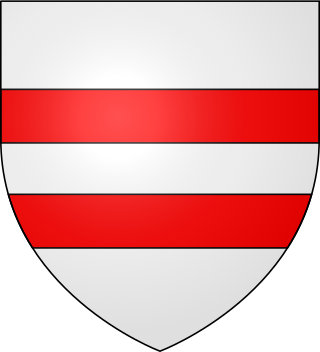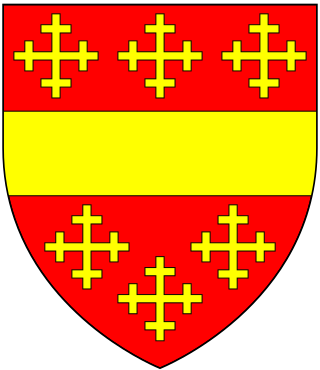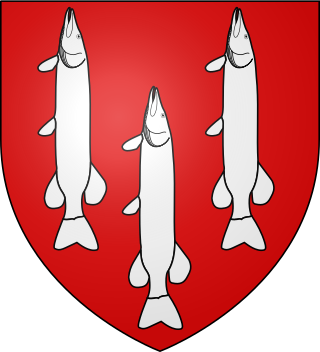
Knaresborough Castle is a ruined fortress overlooking the River Nidd in the town of Knaresborough, North Yorkshire, England.

Joan Beaufort was the youngest of the four legitimised children and only daughter of John of Gaunt, 1st Duke of Lancaster, by his mistress, later wife, Katherine de Roet. She married Ralph de Neville, 1st Earl of Westmorland and in her widowhood became a powerful landowner in the north of England.

William III de Ferrers, 5th Earl of Derby of Chartley Castle in Staffordshire, was an English nobleman and major landowner, unable through illness to take much part in national affairs. From his two marriages, he left numerous children who married into noble and royal families of England, France, Scotland and Wales.

William III de Cantilupe was the 3rd feudal baron of Eaton Bray in Bedfordshire, and jure uxoris was feudal baron of Totnes in Devon and Lord of Abergavenny. His chief residences were at Calne in Wiltshire and Aston Cantlow, in Warwickshire, until he inherited Abergavenny Castle and the other estates of that lordship.

Lionel de Welles, 6th Baron Welles, KG was an English peer who served as Lord Lieutenant of Ireland and Joint Deputy of Calais. He was slain fighting on the Lancastrian side at the Battle of Towton, and was attainted on 21 December 1461. As a result of the attainder, his son, Richard Welles, 7th Baron Welles, did not succeed him in the barony of Welles until the attainder was reversed by Parliament in June 1467.

FitzMartin or Fitz Martin was the surname of a Norman family based in England and Wales between 1085 and 1342.

Vipont is the name of a prominent family in the history of Westmorland. According to Thomas the name originated in France before 1066 as Vieuxpont, Latinized to de Vetere Ponte, with alternative spellings Vezpont, Veepon, Vexpont, Vypont, Vispont, Vypunt, Vespont, Vipond, Vypond, Voypond, Veepond, Vippond, Vipon, Vipan, Vipen, etc. The Vipont family bore arms: Gules, six annulets or 3:2:1, later quartered by Baron Clifford.
Robert III de Stuteville was an English baron and justiciar.

Walter II de Beauchamp, of Elmley Castle in Worcestershire, was hereditary Sheriff of Worcestershire.

Sir John Russell of Kingston Russell in Dorset, England, was a household knight of King John (1199–1216), and of the young King Henry III (1216–1272), to whom he also acted as steward. He served in this capacity as custodian of the royal castles of Corfe and Sherborne (1224) in Dorset and of the castles of Peveril and Bolsover in Derbyshire. He served as Sheriff of Somerset in 1223-1224. He was granted the royal manor of Kingston Russell in Dorset under a feudal land tenure of grand serjeanty. Between 1212 and about 1215 he acquired a moiety of the feudal barony of Newmarch, the caput of which was at North Cadbury, Somerset, in respect of which he received a summons for the military service of one knight in 1218.
William de Warenne, the feudal baron of Wormegay, served as a royal justice under King Richard I and his brother King John. Warenne also served in financial matters, being one of those responsible for collecting taxes and later overseeing debts from Christians to Jews. His career was closely tied to that of Hubert Walter, who employed Warenne as a judge in some ecclesiastical matters. He also founded a priory and gave other gifts to religious houses. The historian Ralph V. Turner said of Warenne that "although he was a longtime official under King John, he did not quite fit into the inner corps of royal counselors".
The feudal barony of Berry Pomeroy was one of eight feudal baronies in Devonshire, England, which existed during the mediaeval era. It had its caput at the manor of Berry Pomeroy, 20 miles south of the City of Exeter and 2 miles east of the town of Totnes, where was situated Totnes Castle, the caput of the feudal barony of Totnes. The exact location of the 11th-century baron's residence is unclear; perhaps it was next to the parish church on the site of the former rectory known as Berry House, as it is now believed that the nearby ruined Berry Pomeroy Castle was not built until the 15th century.

Ralph de Greystoke, 1st Baron Greystoke, was an English peer and landowner.
The feudal barony of Gloucester or Honour of Gloucester was one of the largest of the mediaeval English feudal baronies in 1166, comprising 279 knight's fees, or manors. The constituent landholdings were spread over many counties. The location of the caput at Gloucester is not certain as Gloucester Castle appears to have been a royal castle, but it is known that the baronial court was held at Bristol in Gloucestershire.
The feudal barony of Curry Mallet was an English feudal barony with its caput at Curry Mallet Castle in Somerset, about 7 miles east of Taunton.

Robert Harington, 3rd Baron Harington (1356-1406) of Gleaston Castle in the manor of Aldingham in Furness, Lancashire, was an English peer.
Hugh de Morville Baron of Burgh, Lord of Kirkoswald, was an English noble.

Richard de Luci, sometimes spelt Lucy, Baron of Egremont and Copeland, was an English noble.
Nicholas I de Stuteville Baron of Liddel and Cottingham, was an English noble.
William de Stuteville Baron of Cottingham in the East Riding of Yorkshire, Lord of Buttercrambe in the North Riding of Yorkshire, was an English noble.











